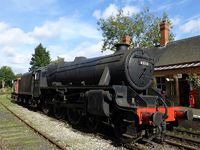LMS Stanier Class 5 45110
45110 in Service
The LMS Stanier Class 5 was an immediate success when introduced into service in 1934. It was a mixed traffic locomotive that could handle anything from express passenger traffic to goods trains. 842 were built, more than any other class of locomotive before or since, and they worked all over the LMS network. Following nationalisation they were classified 5MT by British Railways and quickly became used throughout the country. They were never painted any colour but black, earning them the nickname ‘Black 5s’. The design of the British Railways Standard Class 5 was based on the Black 5.
45110 was built by the Vulcan Foundry as works number 4653/1934, and entered service in June 1935 as LMS 5110. Following nationalisation it was renumbered as 45100 by BR in 1949, and it was one of the very last steam locomotives still in use by BR when it finished its working life at Lostock Hall Shed, Preston.
The last ‘official’ train run by BR was a ‘farewell to steam’ special on 11 August 1968, 8 days after regular steam services had ended. The special train ‘1T57’ became known as the ‘Fifteen Guinea Special’ after the price of tickets. 45110 took the train from Liverpool to Manchester, from where 70013 Oliver Cromwell continued to Carlisle. Two other Black 5s (44781 and 44871) began the return leg, while the honour of the final return to Liverpool fell to 45110, which thereby entered history as the last BR-owned standard gauge steam locomotive to haul a service on the national network.
45110 in preservation
45110 arrived on the SVR on 20 August 1970 in working order and entered service the same year. The first period of service ended 10 years later in 1990 after recording 21,185 miles in use. Following overhaul, a second period of service began in 1998. This lasted until late 2008, including a 6-month boiler ticket extension which enabled the locomotive to celebrate the 40th anniversary of the end of BR main line steam. Both 10 year 'tickets' included hauling main line rail tours.
Following expiry of the second 'ticket' in 2008, 45110 moved on loan to Barrow Hill Roundhouse for a period on static display there. In October 2013 the locomotive returned to the SVR and was moved into The Engine House, taking the place of 4930 Hagley Hall which had moved to Bridgnorth for overhaul.
As at February 2015 the locomotive remains on display in The Engine House while awaiting its next overhaul. It is owned by SVR(H).
